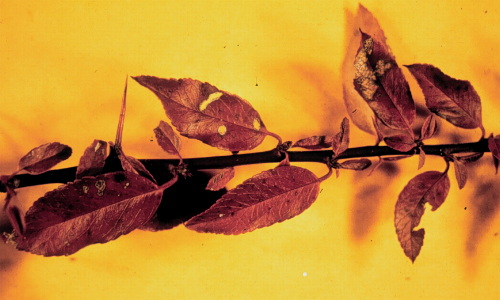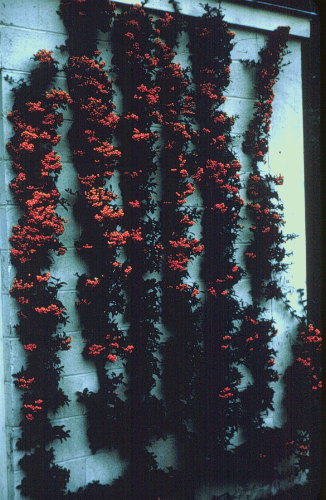Pyracantha coccinea
Scarlet Firethorn
Rosaceae
ExpandHabitat
- native to southeastern Europe, the Himalayas and central China
- zone 6; zone 5 with the best cold hardy cultivars
Habit and Form
- a semi-evergreen to evergreen shrub
- maximum heights of 10' to 12'
- habit is variable from upright and spreading to arching and irregular
- branches are stiff and thorny
- can become open without pruning
Summer Foliage
- simple, evergreen, narrow-elliptical leaves
- alternate leaf arrangement
- 0.6" to 1.5" long and 0.25" to 0.75" wide
- leaf margins shallowly scalloped
- color is lustrous dark green
Autumn Foliage
- although at least semi-evergreen foliage will bronze, turn brown and drop as the winter advances
Flowers
- small white flowers borne in clusters
- blooms contrast nicely against dark green foliage
- showy in flower
- blooms occur on spurwood from last years growth
- bloom time is late May to early June
- flowers are malodorous, but not strongly so
Fruit
- 0.25" diameter berries
- orange-red color
- ripen in September
- persist into winter for a short while
- very showy fruit
- held in clusters in large numbers
Bark
- glossy brown
- not really an ornamental attribute
Culture
- full sun for best performance and fruiting
- tolerant of partial shade
- soil should be well-drained
- tolerant of dry soils once established
- can be pruned at any time
- transplant from a container as it is difficult to transplant when dug from soil
- plant in protected locations due to lack of solid cold hardiness
Landscape Use
- for berries and informal habit
- for espalier
- on trellises
- especially useful for its fruit display
- foundation plant
Liabilities
- fireblight
- aphids, lacebug, mites, scale can be problematic
- lack of solid cold hardiness and winterburn
- scab on fruits
ID Features
- semi-evergreen shrub
- spur-like thorns
- shiny brown bark
- flat clusters of orange-red fruit
- leaf-like stipules at the base os some petioles and winter buds
Propagation
- by cuttings
- by seed
Cultivars/Varieties
Presented here is a selection of those cultivars which are preferable for planting in USDA zones 5 and 6, both for their hardiness and disease resistance. Not all are selections of P. coccinea, as numerous commercially-available forms are complex hybrids or selections of other Pyracantha species.
'Chadwickii' - This is a hardy form (USDA zone 5) producing abundant orange-red fruit. It grows to 6' tall with a spreading habit.
'Gnozam' (Gnome®) - The exact parentage of this cultivar is uncertain, but is is not pure P. coccinea. It is a hardy (zone 5) cultivar with orange-red berries and a dense mounded habit. It grows to 4' to 6' tall.
'Kasan' - Hardy to zone 5 and reaching 8' to 10' tall, this is a compact plant with orange-red berries. It appears susceptible to scab.
'Lalandei' - One of the most widely grown cultivars, this selection is hardy to zone 5 and is a vigorous grower to 10' to 12' tall. It produces abundant orange-red fruits, but the plant is susceptible to scab.
'Mohave' - A hybrid selection, this dense grower (to 12' tall, usually smaller) is popular and features profuse quantities of orange-red berries that are often ignored by birds. It appears to be resistant to scab and fireblight, though it is not as hardy as other forms (zone 6).
'Monon' (Yukon Belle™) - A cultivar of P. angustifolia and perhaps the hardiest form available, this cultivar is listed as zone 4 cold hardy, but is probably most reliable in zone 5. The plant produces orange berries and grows 6' to 8' tall and wide.
'Teton' - A hybrid developed by the U.S. National Arboretum, this plant offers striking upright growth form (to 12'+ tall) and orange fruit. Though it is fireblight resistant, it is less hardy and therefore only useful in zone 6 and warmer.
'Wyattii' - This selection features orange-red fruit and vigorous growth, reaching 10' to 12' tall. Though some observers cite it as being more cold hardy than 'Lalandei', it is susceptible to fireblight and scab.




